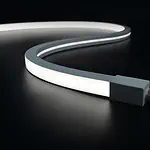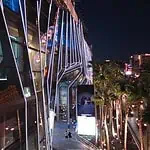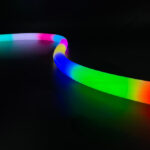Have you ever walked past a neon sign and been struck by its mesmerizing glow? Neon lights have been a popular choice for businesses and homes for decades—all thanks to their eye-catching designs and ability to create a unique ambiance.
Traditional glass neon lights have been around for over a century. At the same time, modern technology has brought about the invention of LED neon lights. Glass neon lights have a timeless appeal. At the same time, LED neon lights offer many advantages, such as energy efficiency and durability. These two types of neon lights have their distinct features. However, it can be challenging to decide which one is better.
In this article, I will dive deep into the world of neon lights and compare the details of glass neon lights to LED neon lights. Therefore, help you decide when to choose the perfect lighting solution for your needs.
What Are Glass Neon Lights?
Glass neon lights are lighting made from glass tubes filled with neon gas. When an electric current is passed through the gas, it emits a bright and colorful light. These lights are often used in commercial signs, as well as in art and home decor.
Creating glass neon lights involves heating and bending glass tubes into the desired shape. Then fill them with a small amount of neon gas. Electrodes are attached to either end of the tube. And when a high voltage is applied, the gas inside the tube ionizes, creating a glowing plasma that emits light.
One of the most notable features of glass neon lights is their vivid and distinctive colors. Neon gas emits a bright red-orange color when excited by an electrical current. But other gasses or combinations of gasses can create different colors. For example, argon gas emits a blue light, while helium gas produces a pinkish-red color.

Advantages of Glass Neon Lights
Glass neon lights have existed for over a century. They are a popular choice for businesses. Here are some advantages of using glass neon lights:
Brightness
Several factors determine the brightness of glass neon lights. They include the type of gas used, the tube diameter, and the voltage and current applied to the tube.
The gas used in the tube plays a significant role in determining the brightness of the neon light. Neon gas, which gives off a bright reddish-orange glow, is the most commonly used in neon lights. However, other gasses, such as argon (blue), helium (pink), krypton (green), and xenon (purple), can produce different colors of light. These gasses determine the color of the light produced. And the brightness of the light is affected by the amount of gas in the tube.
The diameter of the glass tube also plays a role in the brightness of the neon light. A larger tube opens more room for gas to produce a more intense and vibrant illumination. That is, the larger the diameter of the tube, the brighter the light will appear.
Longevity
They are designed to withstand years without losing brightness or color intensity. A glass neon light lasts 10,000 hours, while an incandescent bulb lasts only 1000 hours. This durability of glass neon lights is due to how they are constructed. The glass used to make neon lights is specially designed to be heat-resistant. They can withstand the high temperatures generated during the ionization process.
Customizability
Glass neon lights are customizable and fit almost any design or branding needs. Here are some aspects of glass neon lights you can customize from the manufacturers:
- Shape
Glass neon lights can be bent and shaped into almost any design. This makes them highly customizable. Neon lights can be shaped into letters using specialized glass-blowing techniques. They can also form logos, shapes, and complex designs.
- Color
Neon lights are available in various colors. It can be from standard shades of blue, red, and green to more unusual colors like pink, purple, and yellow. Additionally, different colors can combine to create a unique effect or gradient. However, all these colors depend on the gas used inside the tube.
- Size
Neon lights can be made in various sizes. It can be from small desktop signs to large outdoor installations. The neon lights’ size can easily fit the installation’s space and purpose.
- Font
The glass neon lights can display text. Also, you can customize the font to match the branding or design of the project. Multiple fonts can be recreated in neon lights. And custom fonts can also be created to fit specific branding needs. This want makes them famous for using as neon signage
- Animation
Neon lights can animate or blink in various patterns for a more dynamic effect. These effects can be programmed into the neon lights to create a custom animation.
- Backing
You can mount neon lights on various backings, such as acrylic or metal, to create a unique look. The backing can also be customized with graphics or designs. Thus it complements the neon lights.
- Installation
You can install neon lights in various ways. This includes hanging from the ceiling, mounting on a wall, or placing on a stand. The installation method can be customized to fit the project’s specific needs.
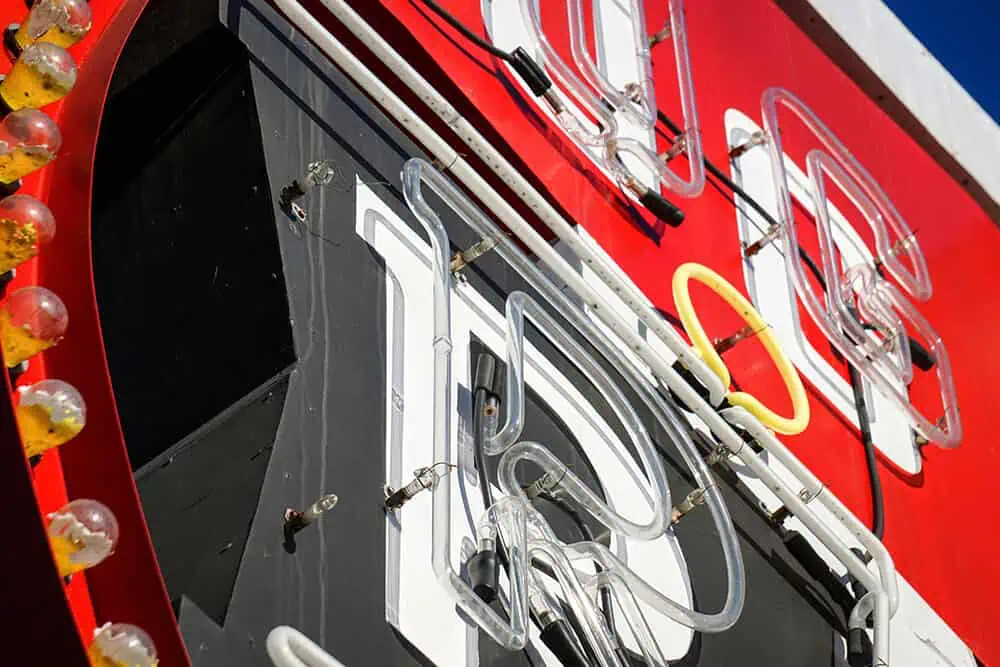
Disadvantages of Glass Neon Lights
While glass neon lights have many advantages, such as their vibrant colors and eye-catching brightness, they also have several disadvantages:
- High Energy Consumption
Glass neon lights’ high energy consumption is due to how they work. These lights are made up of glass tubes filled with neon gas, and when an electric current is passed through the gas, it emits light. This process requires a high voltage, typically around 15,000 volts, to ionize the gas and create the glowing effect. And this high voltage requirement means that they consume a significant amount of energy. In fact, the energy consumption of a single neon light can be several times higher than that of a comparable LED or fluorescent light.
Another factor contributing to glass neon lights’ high energy consumption is their inefficient use. Unlike LEDs, which convert most of the energy into light, glass neon lights convert only a small percentage into light. The rest of the energy is lost as heat. And thus, it wastes energy and also overheats the neon tubes.
- Fragility
The glass tubes of the neon light are thin and delicate, making them fragile. This means they can easily crack or break if dropped or struck with a hard object. In addition, the glass can weaken over time due to exposure to heat, moisture, or UV light, which can cause the glass to become brittle and prone to cracking.
- High Maintenance
Glass neon lights require regular upkeep and repairs to maintain their brightness and functionality, which can be quite expensive. The replacement parts and labor costs can increase quickly, mainly if the lights are used frequently or in harsh environments. Another issue with the high maintenance of glass neon lights is safety. They can be dangerous to handle or work with, especially if safety precautions are not taken. Besides, disposing of broken or outdated neon lights can also be challenging.
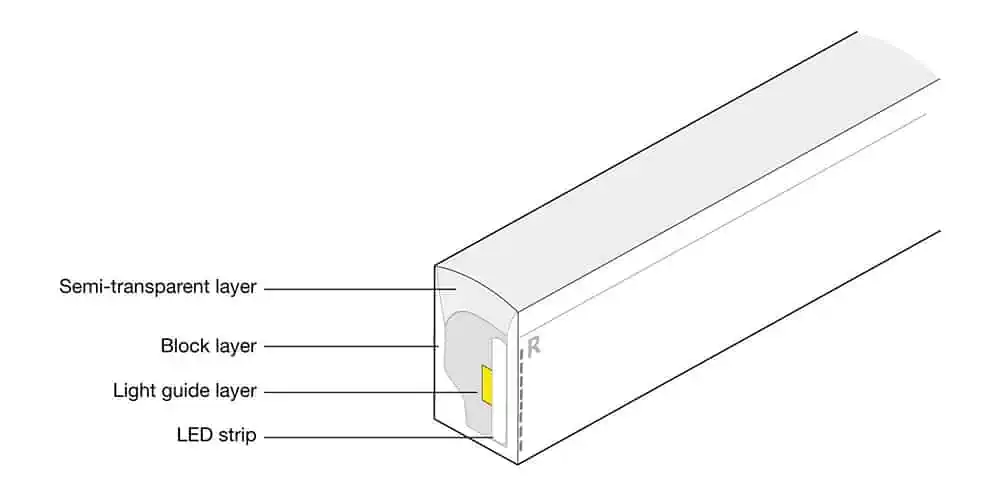
What Are LED Neon Lights?
LED neon lights are a type of lighting technology that emulates the look of traditional neon lights using modern LED technology. Unlike conventional neon lights, which use glass tubes filled with glasses and a high-voltage electrical charge to produce light, LED neon lights use flexible, thin plastic/silicon tubes containing LED lights.
These lights give you the maximum flexibility in designing the neon effect. They come in a flexible rope-like structure that you can bend to different angles to create the required format. LED neon lights come in various colors, including white, red, green, blue, and pink. They can also be made to change colors, often used for decorative purposes. LED neon lights are highly efficient and energy-saving, consuming significantly less energy than traditional neon lights.

Advantages of LED Neon Lights
LED neon lights offer several advantages over traditional neon lights, including
- Energy Efficiency
LED neon lights use up to 80% less energy than traditional neon lights, making them much more energy-efficient. This is because traditional neon lights use gas and high voltage to create light, while LED neon lights use LEDs (Light-Emitting Diodes) to produce light. LEDs use much less energy, which means that LED neon lights are much more energy-efficient.
- Durability
LED neon lights are known for their durability and long lifespan compared to traditional neon lights. These lights are typically constructed using a flexible silicone tube resistant to UV rays, high temperatures, and other environmental factors. Unlike traditional neon lights, LED neon lights use solid-state lighting technology, which means no fragile glass tubes or dangerous gasses are involved. This makes them much more resistant to shock and vibration and less prone to damage or breakage.
Additionally, LED neon lights have a much longer lifespan than traditional neon lights. Traditional neon lights typically last around 10,000 hours, while LED neon lights can last up to 100,000 hours or more. This means LED neon lights require less frequent replacement, saving businesses money in the long run.
- Versatility
One of the most versatile features of LED neon lights is their flexibility. Unlike traditional glass neon lights, LED neon lights can be bent and shaped to fit various applications. It can also be cut to custom lengths, allowing them to fit any space. This means they can be used to create intricate and complex designs previously impossible with traditional neon lights. And to enhance this versatility, LEDYi has come up with a large series of LED neon flex that includes-
- Horizontal Bend Series
- Vertical Bend Series
- 3D(Horizontal & Vertical) Series
- 360° Round Series, and more.
Unlike traditional neon lights, which can produce significant heat, LED neon lights emit very little heat. This makes them more versatile & ideal for use in applications where heat can be a concern, such as in food and beverage displays or retail settings.

- Multiple Color Options
LED neon lights are available in various colors. It can be from standard shades of blue, red, and green to more unusual colors like pink, purple, and yellow. They also offer you a DIY option when connected to a smart controller. Our LEDYi LED neon flex is available in a wide range of options that can provide you with unlimited color options; these include-
- Monochrome
- Tunable White
- RGB
- RGBW
- DMX512 RGB/RGBW addressable LED neon lights

Disadvantages of LED Neon Lights
The modern technology of LED neon lights has eliminated almost all the drawbacks of traditional or glass neon lights. So, there isn’t much to talk about the disadvantages. Yet, some poorly graded LED neon lights available in the market can have the following drawbacks-
- Limited Brightness
LED neon lights may not be able to reproduce specific colors with the same brightness level as traditional neon lights. For example, some shades of orange, pink, or purple may appear muted or dull in LED neon lights. This fact is common for poorly manufactured LEDs. So, it is always better to go for branded and high-quality LED neon flex.
Besides, LED neon lights may be less visible in areas with high ambient light levels. This can be a problem for outdoor signage or installations. That needs to be seen from a distance, such as roadside billboards. But no worries with LEDYi; our LED neon flex’s light source is ultra-high brightness SMD LEDs, with a density of 120 LEDs per meter, guaranteeing high brightness and a uniform luminous effect.
- Directional Lighting Effect
LED neon lights emit light more directionally than traditional neon lights. These flexible light fixtures have a flat rectangular three-dimensional structure that emits light only at the frontal surface/plane. Unlike the glass neon tube, it doesn’t emit light from all dimensions. And this can create a narrower viewing angle in LED neon light. And viewers may need to be positioned at a specific angle to see the full effect. But LEDs with high brightness levels will not cause visibility problems from any direction.

Glass Neon Lights vs. LED Neon Lights: A Comparison
Glass neon lights and LED neon lights are two types of lighting. They are commonly used for signage, decor, and artistic purposes. Both types of lights are used to achieve a similar aesthetic effect. Yet, there are significant differences between the two. Here are some critical differences between glass neon lights and LED neon lights:
Brightness and Intensity
Brightness and intensity are closely related but different. Brightness refers to how well-lit a space is. At the same time, intensity refers to how much light is emitted per unit area. Both factors are essential when evaluating lighting quality in neon lights.
The glass neon light’s brightness depends on the tube’s diameter, the gas color used, and the current applied. A typical glass neon light can emit up to 50 lumens per watt. This makes them less energy-efficient than LED neon lights.
LED neon lights are a newer technology that has become increasingly popular recently. They are bright lights, with a typical LED neon light emitting up to 100 lumens per watt.
| Factors | Glass Neon Lights | LED Neon Lights |
| Brightness | Not as bright | Brighter |
| Intensity | Up to 50 lumens/watt | Up to 100 lumens/watt |
| Energy Efficiency | Less efficient | More efficient |
Energy Consumption
The energy consumption is an essential factor to consider when choosing between glass neon and LED neon lights. Here’s a comparison between the two:
Glass neon lights consist of tubes filled with neon gas, which is ionized by an electrical current to produce a glowing effect. They require a high-voltage transformer to operate and consume significant energy. In contrast, LED neon lights use LED technology to produce a similar glowing effect but with significantly less energy consumption. Here’s a comparison table to summarize the differences in energy consumption between glass neon and LED neon lights:
| Factors | Glass Neon Lights | LED Neon Lights |
| Voltage | 10,000-15,000V | 12-24V |
| Heat Output | High | Low |
| Energy Usage | Expensive | Cost-effective |
| Sustainability | Less efficient, High energy | More efficient, energy saving |
Durability
Regarding durability, both types of lights have their strengths and weaknesses. Let’s compare the two types of lights in terms of durability.
| Glass Neon Lights | LED Neon Lights |
| Glass tubes can be fragile and break if mishandled or exposed to harsh weather conditions. | LED neon lights are made of durable materials like PVC, silicone, or acrylic that can withstand harsh weather conditions and accidental impacts. |
| Glass tubes are filled with a mixture of gas. They require high voltage to light up, which can result in frequent breakages and flickering. | LED neon lights are powered by low voltage and have a long lifespan of up to 100,000 hours, making them more reliable and long-lasting. |
As we can see from the comparison table above, LED neon lights have a clear advantage in terms of durability compared to glass neon lights. LED neon lights are made of durable materials, have a long lifespan, require minimal maintenance, and are energy-efficient. On the other hand, glass neon lights are fragile, require frequent maintenance and replacement, and consume a lot of electricity.
Customizability
Glass neon lights offer customization regarding color and shape. But you can’t shape them by yourself as they are made of glass. Instead, they have to be given a structure in the manufacturing factory. And the shape, once formed, is permanent and can’t be changed- this limits its customizability.
But with LED neon lights, you can customize the shape by yourself. You can also cut them to your desired length. Besides, these are super flexible, which allows you to bend them to your required angles (based on the type of neon flex). So, you can go for DIY lighting with LED neon lights. Check this out to make fantastic signage using LED neon lights- How to Make a DIY LED Neon Sign.

Versatility
Glass neon lights offer a unique aesthetic and are well-suited to specific applications. They are less versatile than LED neon lights. Glass neon lights require more maintenance and are more fragile than LED neon lights. This makes them less suitable for outdoor use or areas where they may be subject to damage.
LED neon lights are more versatile than glass neon lights in their durability and functionality. LED neon lights are weather-resistant and can be used indoors and outdoors. This makes them a better choice for outdoor signage and displays. Additionally, LED neon lights are energy-efficient and have a longer lifespan than glass neon lights. Thus it makes them a more sustainable option.
Price
Glass neon lights are typically more expensive than LED neon lights. They are made by skilled artisans who bend and shape glass tubes. The price of glass neon lights can vary depending on the design’s size, color, and complexity. On average, a glass neon light can cost anywhere from $150 to $500 per linear foot.
On the other hand, LED neon lights are typically much cheaper than glass neon lights. Because they are mass-produced in factories using automated machines. The price of LED neon lights can vary depending on the design’s size, color, and complexity. On average, an LED neon light can cost anywhere from $10 to $30 per linear foot.
Maintenance and Lifespan
Glass neon lights require regular maintenance. This includes cleaning and replacing parts such as transformers and tubes. In addition, glass neon lights are fragile and can break easily, requiring costly repairs. In contrast, LED neon lights require very little maintenance. Also, they are made up of solid-state components that are more durable.
Furthermore, glass neon lights span around 10,000 hours, depending on usage and maintenance. In comparison, LED neon lights have a great lifespan of 50,000-100,000 hours, roughly over seven years. However, LEDYi gives a 3 – 5 years warranty on LED neon flex. And with proper maintenance, they can last longer than a decade.
Safety
The safety comparison between Glass Neon Lights and LED Neon Lights:
- Heat Emission
Glass neon lights produce a lot of heat which can cause fire breakout if not installed correctly. LED neon lights, on the other hand, produce minimal heat and are much safer to use.
- Breakage
Glass neon lights are fragile and can break easily. Broken glass can cause serious injury and can be a safety hazard. LED neon lights are made of plastic/silicon/PU, making them super flexible. So, they are a safer option with no fear of breakage.
- Toxicity
Glass neon lights contain toxic neon gas that can be harmful if inhaled. LED neon lights do not contain any toxic materials and are much safer to use.
| Safety Aspect | Glass Neon Lights | LED Neon Lights |
| Heat Emission | High | Minimal |
| Electrical Consumption | High | Low |
| Breakage | Fragile and prone to breakage | Sturdy and less prone to breakage |
| Toxicity | Contains toxic neon gas | Does not contain any toxic materials |
| Lifespan | Long lifespan with high maintenance | Longer lifespan |
Environmental Comparison
Glass neon lights are not recyclable due to their high content of lead and other hazardous materials. When glass neon lights are broken or disposed of improperly, they can release these harmful substances into the environment. On the other hand, LED neon lights are more environmentally friendly. They are made with non-toxic materials that can be recycled quickly and safely.
Glass Neon Lights vs. LED Neon Lights: Which Is Best & Why?
Glass neon lights have a classic look and can add a touch of nostalgia to your space. However, they are less energy-efficient and have a shorter lifespan. And they are more fragile than LED neon lights. Glass neon lights also have limited customization options. Additionally, they operate at high voltages, which can pose safety risks.
On the other hand, LED neon lights are more energy-efficient and have a longer lifespan. And they are sturdier than glass neon lights. They offer greater flexibility in terms of customization. They can be cut and programmed to display various colors and patterns. LED neon lights also operate at low voltages, making them safer.
Ultimately, LED neon lights are the better choice for most applications. The reasons are their energy efficiency, durability, safety, and affordability. However, if you’re looking for a vintage look, glass neon lights can give a better classical neon effect.

FAQs
In general, glass neon lights are more expensive than LED neon lights due to the manufacturing process and materials involved. These are made of glass and gasses that are expensive compared to the plastic and silicon material used in LED neon lights.
Glass neon lights are made using glass tubes filled with neon gas. At the same time, LED neon lights use flexible LED strips or modules encased in plastic, silicone, or PU.
Both glass and LED neon lights can be used for indoor and outdoor applications. But, certain glass neon lights may require additional weatherproofing. But, LED neon lights have a wide range of IP rating that provides water and dust resistance. Besides, LED neon lights with IP67 resist saline solutions, acid & alkali, corrosive gasses, fire, and UV. These features make them ideal for both indoor and outdoor usage.
LED neon lights are generally easier to install than glass neon lights due to their flexibility and lightweight. You can cut them into your required measurement and shape them to your desired shape. Then all you need to do is fix the mounting clips/channels, then press the LED neon flex into it. Then connect it to the power source, and your installation is done.
LED neon lights are super flexible and can be bent to give any shape. This feature makes them ideal for creating intricate designs or shapes.
The lifespan of glass neon lights can vary depending on usage and maintenance. But they typically last for up to 10,000 hours. In contrast, LED neon lights can last up to 100,000 hours.
The color of Glass neon lights depends on the gas used in the tube. This fact limits the color range for glass neon lights. Meanwhile, LED neon lights are available in a wide variety of colors. Besides, the RGB, RGBW, and DMX512 RGB/RGBW addressable LED neon lights take the color range to the next level.
Glass neon lights can produce more heat due to the energy required to light the glass tubes. In contrast, no gas is required in LED neon light, and it runs at low voltage, which doesn’t let the fixture get overheated.
Yes, Glass neon lights are more fragile as they are made of glass. And so they can be easily damaged if handled correctly. In contrast, LED neon lights are made of plastic/silicon materials that make them robust.
Safety concerns with glass neon lights include the risk of electric shock. Also, it can be broken glass and potential exposure to hazardous gasses.
Glass neon lights have a classic, retro appearance. At the same time, LED neon lights can be made to look more modern and sleek.
Related Articles
15 Things You Need to Know Before Buying LED Neon Flex
Top 10 LED Neon Light Manufacturers and Suppliers in China
How to Make a DIY LED Neon Sign
The Ultimate Guide to LED Neon Flex Lights

Summary of Comparison
The battle between glass and LED neon lights is fierce. Both sides offer unique advantages and disadvantages. LED neon lights are more energy-efficient, durable, and customizable. At the same time, glass neon lights offer a classic look and a certain nostalgic charm.
At LEDYi Lighting, we offer a wide range of neon flex products that utilize LED technology. They will provide numerous benefits over traditional glass neon lights. Whether you want to add some pizzazz to your business signage or create a cozy ambiance in your home, our LED neon lights are the perfect solution. So, if you want to switch to LED neon flex lights today and take your lighting game to the next level, Contact us soon!
